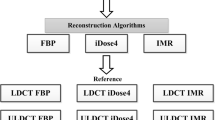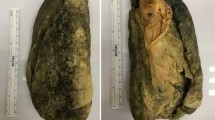Abstract
Objectives
The aim of this study was to evaluate the utility of the iterative reconstruction (IR) technique for quantitative bronchial assessment during low-dose computed tomography (CT) as a substitute for standard-dose CT in patients with/without chronic obstructive pulmonary disease.
Methods
Fifty patients (mean age, 69.2; mean % predicted FEV1, 79.4) underwent standard-dose CT (150mAs) and low-dose CT (25mAs). Except for tube current, the imaging parameters were identical for both protocols. Standard-dose CT was reconstructed using filtered back-projection (FBP), and low-dose CT was reconstructed using IR and FBP. For quantitative bronchial assessment, the wall area percentage (WA%) of the sub-segmental bronchi and the airway luminal volume percentage (LV%) from the main bronchus to the peripheral bronchi were acquired in each dataset. The correlation and agreement of WA% and LV% between standard-dose CT and both low-dose CTs were statistically evaluated.
Results
WA% and LV% between standard-dose CT and both low-dose CTs were significant correlated (r > 0.77, p < 0.00001); however, only the LV% agreement between SD-CT and low-dose CT reconstructed with IR was moderate (concordance correlation coefficient = 0.93); the other agreement was poor (concordance correlation coefficient <0.90).
Conclusions
Quantitative bronchial assessment via low-dose CT has potential as a substitute for standard-dose CT by using IR and airway luminal volumetry techniques.
Key points
• Quantitative bronchial assessment of COPD using low-dose CT is possible.
• Airway luminal volumetry with iterative reconstruction is insusceptible to dose reduction.
• Filtered back-projection is susceptible to the effect of dose reduction.
• Wall area percentage assessment is easily influenced by dose reduction.



Similar content being viewed by others
Abbreviations
- COPD:
-
chronic obstructive pulmonary disease
- FBP:
-
filtered back-projection
- FEV1:
-
percent predicted forced expiratory volume in 1 s
- IR:
-
iterative reconstruction
- %LAA:
-
percentage of low attenuation area
- LV%:
-
luminal volume percentage
- PFT:
-
pulmonary function test
- WA%:
-
wall area percentage
References
Mishima M, Oku Y, Kawakami K et al (1997) Quantitative assessment of the spatial distribution of low attenuation areas on X-ray CT using texture analysis in patients with chronic pulmonary emphysema. Front Med Biol Eng 8:19–34
Nakano Y, Müller NL, King GG et al (2002) Quantitative assessment of airway remodeling using high resolution CT. Chest 122:271S–275S
Betsuyaku T, Nishimura M, Takeyabu K et al (1999) Neutrophil granule proteins in bronchoalveolar lavage fluid from subjects with subclinical emphysema. Am J Respir Crit Care Med 159:1985–1991
Coxson HO, Rogers RM, Whittall KP et al (1999) A quantification of the lung surface area in emphysema using computed tomography. Am J Respir Crit Care Med 159:851–856
Park KJ, Bergin CJ, Clausen JL (1999) Quantitation of emphysema with three-dimensional CT densitometry: comparison with two-dimensional analysis, visual emphysema scores, and pulmonary function test results. Radiology 211:541–547
Hasegawa M, Nasuhara Y, Onodera Y et al (2006) Airflow limitation and airway dimensions inchronic obstructive pulmonary disease. Am J Respir Crit Care Med 173:1309–1315
Matsuoka S, Kurihara Y, Yagihashi K, Hoshino M, Nakajima Y (2008) Airway dimensions at inspiratory and expiratory multisection CT in chronic obstructive pulmonary disease: correlation with airflow limitation. Radiology 248:1042–1049
Koyama H, Ohno Y, Yamazaki Y et al (2012) Quantitative bronchial luminal volumetric assessment of pulmonary function loss by thin-section MDCT in pulmonary emphysema patients. Eur J Radiol 81:384–388
Koyama H, Ohno Y, Nishio M et al (2012) Three-dimensional airway lumen volumetry: comparison with bronchial wall area and parenchymal densitometry in assessment of airway obstruction in pulmonary emphysema. Br J Radiol 85:1525–1532
Gelb AF, Schein M, Kuei J et al (1993) Limited contribution of emphysema in advanced chronic obstructive pulmonary disease. Am Rev Respir Dis 147:1157–1161
Hogg JC, Wright JL, Wiggs BR, Coxson HO, Opazo Saez A, Paré PD (1994) Lung structure and function in cigarette smokers. Thorax 49:473–478
Kubo T, Lin PJ, Stiller W et al (2008) Radiation dose reduction in chest CT: a review. AJR Am J Roentgenol 190:335–343
Ohno Y, Takenaka D, Kanda T et al (2012) Adaptive iterative dose reduction using 3D processing for reduced- and low-dose pulmonary CT: comparison with standard-dose CT for image noise reduction and radiological findings. AJR Am J Roentgenol 199:W477–W485
Nishio M, Matsumoto S, Ohno Y et al (2012) Emphysema quantification by low-dose CT: potential impact of adaptive iterative dose reduction using 3D processing. AJR Am J Roentgenol 199:595–601
Mets OM, Willemink MJ, de Kort FP et al (2012) The effect of iterative reconstruction on computed tomography assessment of emphysema, air trapping and airway dimensions. Eur Radiol 22:2103–2109
Yang Z, Zamyatin AA, Akino N (2011) Effective datadomain noise and streak reduction for X-ray CT. In: Kachelriess M, Rafecas M (eds) Proceedings 11th International Meeting on Fully Three-Dimensional Image Reconstruction in Radiology and Nuclear Medicine, 11–15 July 2011, Potsdam, pp 290–294
Yang Z, Silver MD, Noshi Y (2011) Adaptive weighted anisotropic diffusion for computed tomography denoising. In: Kachelriess M, Rafecas M (eds) Proceedings 11th International Meeting on Fully Three-Dimensional Image Reconstruction in Radiology and Nuclear Medicine, 11–15 July 2011, Potsdam, pp 210–214
Yamashiro T, Miyara T, Takahashi M et al (2012) Lung image quality with 320-row wide-volume CT scans: the effect of prospective ECG-gating and comparisons with 64-row helical CT scans. Acad Radiol 19:380–388
Lin LI (1989) A concordance correlation coefficient to evaluate reproducibility. Biometrics 45:255–268
McBride GB (2005) A proposal for strength-of-agreement criteria for Lin’s concordance correlation coefficient. NIWA Client Report: HAM2005-062. http://www.medcalc.org/download/pdf/McBride2005.pdf. Accessed 22 Jun 2014
Kubo T, Ohno Y, Gautam S et al (2008) Use of 3D adaptive raw-data filter in CT of the lung: effect on radiation dose reduction. AJR Am J Roentgenol 191:1071
Silva AC, Lawder HJ, Hara A, Kujak J, Pavlicek W (2010) Innovations in CT dose reduction strategy: application of the adaptive statistical iterative reconstruction algorithm. AJR Am J Roentgenol 194:191–199
Prakash P, Kalra MK, Digumarthy SR et al (2010) Radiation dose reduction with chest computed tomography using adaptive statistical iterative reconstruction technique: initial experience. J Comput Assist Tomogr 34:40–45
Prakash P, Kalra MK, Ackman JB et al (2010) Diffuse lung disease: CT of the chest with adaptive statistical iterative reconstruction technique. Radiology 256:261–269
Yanagawa M, Honda O, Yoshida S et al (2010) Adaptive statistical iterative reconstruction technique for pulmonary CT: image quality of the cadaveric lung on standard- and reduced-dose CT. Acad Radiol 17:1259–1266
Pontana F, Pagniez J, Flohr T et al (2011) Chest computed tomography using iterative reconstruction vs filtered back projection. Part 1. Evaluation of image noise reduction in 32 patients. Eur Radiol 21:627–635
Koyama H, Ohno Y, Yamazaki Y et al (2010) Quantitatively assessed CT imaging measures of pulmonary interstitial pneumonia: effects of reconstruction algorithms on histogram parameters. Eur J Radiol 74:142–146
Ley-Zaporozhan J, Ley S, Weinheimer O et al (2008) Quantitative analysis of emphysema in 3D using MDCT: influence of different reconstruction algorithms. Eur J Radiol 65:228–234
Pontana F, Duhamel A, Pagniez J et al (2011) Chest computed tomography using iterative reconstruction vs filtered back projection. Part 2. Image quality of low-dose CT examinations in 80 patients. Eur Radiol 21:636–643
d’Agostino AG, Remy-Jardin M, Khalil C et al (2006) Low-dose ECG-gated 64-slices helical CT angiography of the chest: evaluation of image quality in 105 patients. Eur Radiol 16:2137–2146
Sun Z (2007) Multislice CT angiography in aortic stent grafting: relationship between image noise and body mass index. Eur J Radiol 61:534–540
Acknowledgments
The authors wish to thank Kazuyuki Kobayashi, M.D., Ph.D., Yasuhiro Funada, M.D., Ph.D., and Yoshikazu Kotani, M.D., Ph.D., Yoshihiro Nishimura, M.D., Ph.D., (Division of Respiratory Medicine, Department of Internal Medicine, Kobe University Graduate School of Medicine) and Yoshimasa Maniwa, M.D., Ph.D. (Department of General Thoracic Surgery, Kobe University Graduate School of Medicine).
This work was supported by grants-in-aid for scientific research from the Japanese Ministry of Education, Culture, Sports, Science and Technology (JSTS, KAKENHI; No. 22791197); and Toshiba Medical Systems Corporation.
The scientific guarantor of this publication is Hisanobu Koyama, M.D., Ph.D., Kobe University School of Medicine. The authors of this manuscript declare relationships with the following companies: Toshiba Medical Systems Corporation. No complex statistical methods were necessary for this paper. Institutional Review Board approval was obtained. Written informed consent was obtained from all subjects (patients) in this study. Some study subjects have been previously reported by Nishio et al. [14]. However, the key points of our current study were different as our current study assessed the bronchus whereas the previous study assessed the lung parenchyma. New subjects were included in our current study. Methodology: retrospective, diagnostic or prognostic study, performed at one institution.
Author information
Authors and Affiliations
Corresponding author
Rights and permissions
About this article
Cite this article
Koyama, H., Ohno, Y., Nishio, M. et al. Iterative reconstruction technique vs filter back projection: utility for quantitative bronchial assessment on low-dose thin-section MDCT in patients with/without chronic obstructive pulmonary disease. Eur Radiol 24, 1860–1867 (2014). https://doi.org/10.1007/s00330-014-3207-9
Received:
Revised:
Accepted:
Published:
Issue Date:
DOI: https://doi.org/10.1007/s00330-014-3207-9




